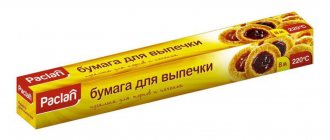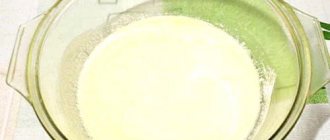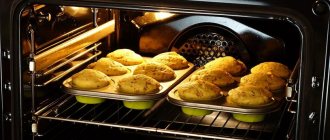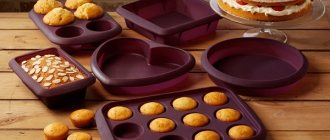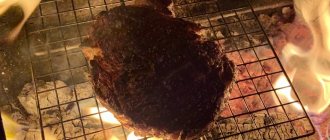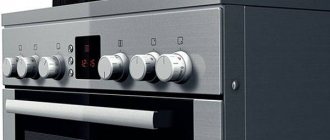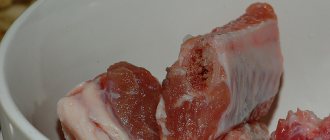Publication in the group: Kitchenware
Parchment paper is a necessary attribute in the kitchen. It protects dishes from carbon deposits, and baked goods, meat dishes or desserts from burning. It is important to be able to choose parchment depending on the purpose set for it and learn the rules on how to use it: lay it in a mold and remove the paper after cooking.
What is culinary parchment and what is it for?
Culinary parchment is porous filtered paper that has undergone special treatment, as a result of which it does not burn, does not break at high temperatures and does not become soggy from moisture.
To make parchment, a porous sheet of cellulose is used, which is treated with 50% sulfuric acid (it slightly destroys the cellulose, making the paper more flexible, clogs the pores, preventing it from getting wet), washed in special waters, and then subjected to long-term drying. Next, the paper is cut into the required sizes and packaged in sheets or rolls.
Properly made parchment has the following properties:
- allows air to pass through well, but does not allow the product to swirl;
- does not ignite at high temperatures;
- does not allow moisture and fat to pass through;
- does not stick or burn to dishes;
- does not change texture after heat or after getting wet;
- can be reused for baking, especially if the parchment contains silicone.
In addition, properly made parchment should consist of environmentally friendly material.
In the kitchen, parchment is used for the following purposes:
- it protects the dishes from grease and carbon deposits; when using it, it is enough to wash the dishes (after preparing the dish) with a soft sponge and detergent;
- prevents burning of foods (dough, meat, vegetables and other ingredients), convenient when the cookware you are using has “lost” its non-stick properties;
- makes it easier to remove finished baked goods from the mold, since they do not stick to the mold;
- You can roll out the dough thinly on paper; it will prevent it from sticking to the table (it is not necessary to use flour;
- protects the table when decorating desserts. To do this, just cover the working surface of the table with paper;
- retains moisture in meat and vegetables. To do this, the products need to be wrapped in parchment before baking;
- the parchment can be rolled into a cone, cut off its sharp tip, and used as a “construction” instead of a pastry bag when decorating desserts. It will not get wet and will not spread from any type of cream;
- allows you to keep baked goods in the desired shape, which is specified by parchment;
- You can seal baked goods, cooked meats, and sausages in parchment. It will prevent the products from spinning and becoming saturated with foreign odors.
You can cook on high-quality parchment paper without using oil, resulting in low-calorie and low-fat dishes.
Types of parchment
Baking parchment, which is easy to use, is available in 3 types:
- unbleached;
- classical;
- with silicone.
Food grade unbleached parchment
Parchment is made from fat-ground cellulose; it retains fat well, but gets wet when exposed to moisture and cannot withstand temperatures above 170 degrees.
Baking parchment - pictured is the food-grade unbleached version.
Therefore, the unbleached version is used for sealing foods or for preparing baked goods. The advantage of paper is environmental friendliness and safety.
Plain parchment
The classic version of parchment is made from porous cellulose sheets that have been treated with acid. It is usually brown in color, does not get wet from moisture, and can withstand high temperatures up to 230 degrees. And if the paper is made in compliance with all the rules, then it (only for baking, not suitable for meat or vegetables) can be used up to 5 times.
Parchment with silicone
The version with silicone coating is distinguished by its increased heat resistance (up to 300 degrees), long shelf life and fairly thick thickness when compared to previous versions.
The paper does not smoke, does not absorb moisture and fat, and (when exposed to high temperatures) does not emit harmful substances. In addition, it does not need to be lubricated with oil; food does not stick to it due to its smooth surface.
Terms of use
Baking parchment, which must be used in compliance with special rules, will fulfill its purpose if the following subtleties of its use are observed:
| List of rules | Notes |
| When purchasing, study the composition of the parchment | It should not contain harmful components. Typically the composition includes cellulose or cellulose with silicone. |
| Check the paper for smell | If it has chemical aromas, then it is better not to take it. |
| Check in the instructions whether the parchment needs to be treated with oil when cooking and what temperature it can withstand. | On the paper packaging, the manufacturer indicates whether the parchment needs to be treated with oil or in what cases it is required. It should also indicate what temperature the paper can withstand and how many times it can be used. |
| Lubricate parchment only with high-quality oil | It is recommended to use refined vegetable oil, butter according to GOST or margarine for baking. |
| If the paper sticks to the baked goods, then you need to wait until the product has cooled down | After cooling, turn the baked goods over and lightly moisten the parchment with water. After this, it will easily separate from the dough without damaging the integrity of the crust. |
| The paper should not hang over the edges of the form. | If the paper hangs over, it should be cut with scissors, otherwise the edges may catch fire. |
| Do not cut the paper end-to-end, it is better to spare | If you cut the paper end to end, the batter or meat sauce may leak out of the edges of the paper. |
Important. It is strictly forbidden to use parchment for cooking on a grill or in other devices with an open fire.
Baking in the oven
The introduction of parchment quickly became widespread due to its multifunctional use. With its help, you can not only prepare homemade pastries, you can also simply bake poultry, fish, and meat with it. Some housewives place a sheet of parchment on the frying pan while frying the cutlets. This reduces vegetable oil consumption and makes washing dishes easier.
Before using baking parchment in the oven, you need to adjust it to the size of the baking dish. If necessary, it can be oiled with any cooking oil. It is important to remember that you need to lay the parchment with the glossy side up.
To lubricate or not
Whether or not to oil parchment depends on what type of paper you purchased. If it is made with a silicone coating, then it does not need to be lubricated with oil. If the parchment is classic or unbleached, then the manufacturer indicates on the packaging whether it needs oiling or not.
You should also consider the purpose for which the paper is being used. For example, when baking shortcrust pastry products, oil is not required. It is sufficiently released from the dough during baking.
What can you cook on parchment in the oven, features of use
Parchment paper can be used not only for baking, but also for meat, vegetables and other products. Depending on the purpose of using parchment, the rules of use change.
Baking
When baking, parchment protects the baked goods from burning. Also, when preparing products with filling (especially sweet buns), the paper protects the baking sheet from burning burnt sugar, which is quite problematic to remove from the surface of the mold.
When preparing baked goods, parchment should be cut to the desired size, placed on a baking sheet and greased with good vegetable oil using a pastry brush. Form the dough into products and place them on paper. Cut off the edges sticking out from the mold. Let the dough rise (takes about 40-60 minutes). After this, the product can be carefully coated with egg (to add gloss) or sprinkled with sugar.
Cake layers
Parchment also helps when preparing cakes, especially if they are prepared with different fillings (cocoa, vanilla, cinnamon). When using paper, there is no need to wait for the mold to cool down, then rinse it and dry it so that it is suitable for baking the next cake. Parchment allows the cake to bake evenly and not burn on the bottom.
To use, the parchment must first be cut into the desired shape (the paper can be given either a round or square appearance). The parchment should cover not only the bottom of the pan, but also the sides. Before filling the form with dough, the paper must be oiled with melted butter or high-quality vegetable oil. And after readiness, the cake is removed from the mold along with the parchment.
If the parchment was poorly oiled and stuck to the dough, then you can make it easier to remove without damaging the crust using the following methods:
- moisten the paper with a damp brush or rag;
- carefully cut the parchment using a knife with a thin and even blade;
- place the cake with paper on a damp cloth.
If the chosen type of parchment sticks to the cake, it should be changed the next time you prepare the dessert.
Pie
When baking a pie, parchment also protects the bottom of the product from burning and the pan from soot. When using paper, you need to cut it into the required shape and cover the baking container with it (the parchment should also cover the sides of the pan if the cake is baked from batter). Next, the parchment should be oiled, and then fill the mold with dough (or put the pie blank in it). If necessary, the dough is allowed to rise.
Meat and poultry
Parchment can also be used when cooking meat, vegetables, fish and other products in the oven. To do this, the paper is cut into the required shape. Cover a baking sheet with it (or simply place it on it) and oil it well. Lay out the food for cooking, make sure that the sauce does not flow into the pan and trim off the excess edges of the paper. You can also lift the edges of the paper and fasten them with a toothpick, then during cooking more juices will be retained in the dish, and the ingredients used will be well baked.
If you want the food to brown, you should cut off the top of the parchment approximately 10 minutes before turning off the oven.
Interesting to know. High-quality parchment paper can be used for cooking in a frying pan, in a slow cooker, and also for boiling products in it.
Which side should you put on the baking sheet?
If you look closely at the baking paper, you will notice that its sides, like those of foil, differ from each other. Before using parchment for baking, you need to understand which side to lay it on the baking sheet.
It is necessary to lay the paper with the glossy side up, this will help distribute the temperature more evenly over the surface. Experienced housewives, before the widespread appearance of parchment, used ordinary notebook sheets, pre-treating them with vegetable oil.
How to remove leftover parchment paper from finished baked goods?
When using parchment paper, situations sometimes arise that the parchment sticks to the finished product.
This can happen in the following cases:
- the parchment was placed in the mold with the matte side up;
- The wrong type of paper was used. Baking parchment is different from that used for fish, meat or vegetables;
- the paper was poorly oiled;
- the dough used was very runny.
Also, the parchment will stick if the heating in the oven is not working correctly, and all the heat of the fire falls on the bottom of the pan. To remove stuck parchment from the product, you need to moisten it, but only after the baked goods (meat, fish or vegetables) have cooled.
Cake layers
Parchment paper is very convenient to use when baking cake layers for various cakes. They often come in a wide variety of shapes and thicknesses. It happens that when baking a thick cake, the top quickly browns and begins to burn. The cake itself remains raw. In this case, a sheet of parchment paper is oiled and the surface of the dough is covered with it.
Using parchment for baking cakes, like any other product, is very simple. It is enough to adjust a sheet of paper to the size of the mold using a knife or scissors, grease it with vegetable oil if necessary and lay out the dough. It happens that after cooking, the parchment is firmly fried to the cake. To separate it, there are several ways:
- wipe the slightly cooled paper with a damp cloth to soak it;
- you can cut the leaf with a knife with a long, thin blade;
- Place the mold with the hot cake on a damp cloth and hold for 10-15 minutes.
If the problem with paper recurs frequently, it is better to use a product from another company.
What happens if you eat parchment paper?
Baking parchment, which can be used to prepare a variety of dishes, cannot always be completely removed from the prepared product. Therefore, sometimes the dish can be served with small pieces of paper.
Since parchment has a natural composition, after consumption it will not cause harm to the body and will be safely digested. It is possible that the cellulose may swell slightly without causing discomfort in the digestive tract.
Homemade pie
Many people are often faced with the question of how to use parchment to bake a cake. The principle of operation of popular paper is the same as for any other confectionery products. Usually, instructions for use can be found directly on the parchment packaging.
The emergence of various household appliances has made it easier for many housewives to work in the kitchen. The multicooker has become a truly indispensable device. With its help it is very easy to prepare a wide variety of dishes, and some even bake homemade pies in it. Even then, you can use parchment paper. This will prevent the baked goods from burning, and it will be much easier to clean the pan later.
How to choose parchment paper, manufacturers and prices
If you decide to purchase parchment paper, then before purchasing you need to study the features of choosing a product:
- high-quality parchment is sold only in “good” stores. Eateries are more likely to sell counterfeits;
- give preference to parchment in the form of a roll (it is more convenient to use) and packaged in cardboard containers;
- the packaging of the parchment should indicate the composition, what temperature it can withstand and whether it needs to be coated with oil;
- thin paper is more suitable for rolling out dough, protecting the table when decorating desserts, as well as when baking low-fat and non-liquid products;
- classic is suitable for both baking and cooking meat, vegetables or fish;
- give preference to silicone-coated parchment; it is more durable, can withstand high temperatures and does not require the use of oil.
Important. Parchment from a trusted manufacturer is always expensive.
A short list of popular brands and prices for parchment:
| List of manufacturers | Prices (in rub.) | Characteristics |
| Clean Wrap (Korea) | 300-1000 | The parchment is coated with silicone on both sides. The product can withstand heat up to 220 degrees. |
| Wilton (USA) | 620-900 | The paper has a silicone coating and can withstand heat up to 200 degrees. |
| Paclan (Poland) | 100-400 | The parchment has a double-sided silicone coating and, as a result, does not stick to either the pan or the baked goods. The paper can withstand heating up to 220 degrees. |
| Nordic (Norway) | 400-900 | The paper is coated with silicone on both sides and can withstand temperatures up to 300 degrees. |
| Toppits (Poland) | 300-900 | The parchment is professional and coated with silicone on both sides. Withstands heat up to 250 degrees. |
| Master FRESH (Russia) | 120-400 | Paper with double-sided silicone coating. The product can withstand heat up to 230 degrees. |
| Freken BOK (Ukraine) | 100-300 | The parchment is coated with silicone on both sides and can withstand heat up to 230 degrees. |
The lowest prices for parchment paper are found in online stores, especially if more than one package is purchased. You need to be careful not to buy a fake.
How can I replace baking paper?
If you need to prepare baked goods, but parchment is not available, you can replace it with the following devices:
- thin silicone mats, which also withstand high temperatures well and do not require the use of oil;
- foil. The substitute must be coated with oil, it reduces the baking time;
- sleeve used for baking. When using it, the use of oil is mandatory;
- blank album sheets. It is important to soak the paper well with oil;
- tracing paper for drawing. The paper must be coated with oil;
- Teflon paper. When using it, oil is not necessary.
In the absence of the listed substitutes, the use of semolina is allowed. The finished dish will be covered with a hard and crispy crust.
How to make parchment paper at home
It is impossible to make parchment paper that fully matches the characteristics of purchased paper at home. The closest thing to parchment is tracing paper. It must first be thoroughly soaked in oil (but not overdo it). Wait until the oil is absorbed. After this, tracing paper can be used instead of parchment paper. If you choose high-quality tracing paper, it can be used up to 5 times.
Parchment helps protect food from burning and dishes from soot. Paper allows baked goods to bake evenly. Before purchasing it, experts recommend familiarizing yourself with the types of parchment, the intricacies of its selection and use.
Butter buns
Fans of homemade baking often encounter such a nuisance as burning. In addition, products with filling often leave black fried marks on the baking sheet, which are quite difficult to wash off. If you know how to use parchment for baking buns, this problem can be easily avoided.
If you are planning to make buns at home, you should get some parchment paper. The sheet is spread on a dry and clean baking sheet, if necessary, the protruding edges are trimmed and greased with vegetable oil. The dough is placed on parchment and left to rise in a warm place.
If you need to quickly prepare baked goods and there is no way to buy special paper, it can be easily replaced.
- You can use tracing paper instead of parchment. It is often used when sewing or drawing. This paper is thinner but has similar quality to processed pulp. Having covered the baking sheet, it must be coated with oil or fat.
- Foil, also greased with oil, is often used as a substitute for parchment. However, you should carefully monitor the baking. Thin metallized paper can increase the temperature, thereby speeding up the cooking process.
- Recently, many housewives have been using silicone baking products. These are all kinds of rugs, molds for bread, cookies, and cakes. Using them in the kitchen, you can do without parchment.
- Use the tools at hand to effectively replace baking paper. Notebook, landscape, oiled sheets, baking sleeve, treated with fat. Even a foil wrapper for butter can successfully replace popular paper.
To avoid troubles, you should not use newspapers, cardboard, plastic bags, or plain paper for baking without pre-oiling.
